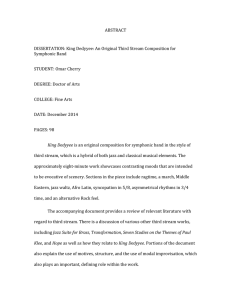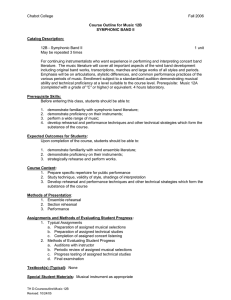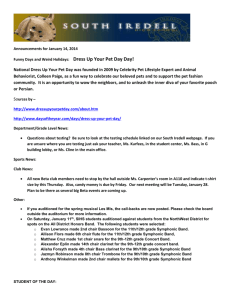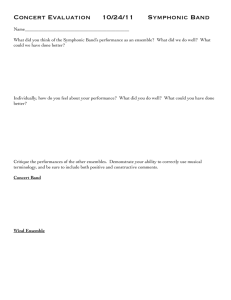MPAME-GE 2111
advertisement
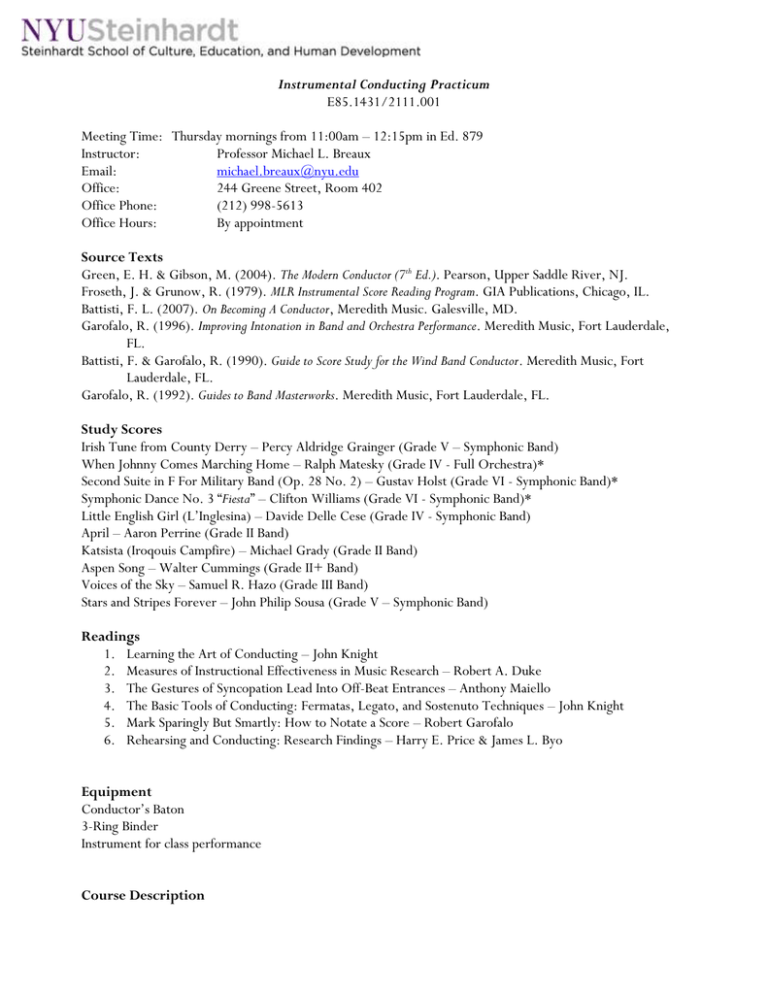
Instrumental Conducting Practicum E85.1431/2111.001 Meeting Time: Thursday mornings from 11:00am – 12:15pm in Ed. 879 Instructor: Professor Michael L. Breaux Email: michael.breaux@nyu.edu Office: 244 Greene Street, Room 402 Office Phone: (212) 998-5613 Office Hours: By appointment Source Texts Green, E. H. & Gibson, M. (2004). The Modern Conductor (7th Ed.). Pearson, Upper Saddle River, NJ. Froseth, J. & Grunow, R. (1979). MLR Instrumental Score Reading Program. GIA Publications, Chicago, IL. Battisti, F. L. (2007). On Becoming A Conductor, Meredith Music. Galesville, MD. Garofalo, R. (1996). Improving Intonation in Band and Orchestra Performance. Meredith Music, Fort Lauderdale, FL. Battisti, F. & Garofalo, R. (1990). Guide to Score Study for the Wind Band Conductor. Meredith Music, Fort Lauderdale, FL. Garofalo, R. (1992). Guides to Band Masterworks. Meredith Music, Fort Lauderdale, FL. Study Scores Irish Tune from County Derry – Percy Aldridge Grainger (Grade V – Symphonic Band) When Johnny Comes Marching Home – Ralph Matesky (Grade IV - Full Orchestra)* Second Suite in F For Military Band (Op. 28 No. 2) – Gustav Holst (Grade VI - Symphonic Band)* Symphonic Dance No. 3 “Fiesta” – Clifton Williams (Grade VI - Symphonic Band)* Little English Girl (L’Inglesina) – Davide Delle Cese (Grade IV - Symphonic Band) April – Aaron Perrine (Grade II Band) Katsista (Iroqouis Campfire) – Michael Grady (Grade II Band) Aspen Song – Walter Cummings (Grade II+ Band) Voices of the Sky – Samuel R. Hazo (Grade III Band) Stars and Stripes Forever – John Philip Sousa (Grade V – Symphonic Band) Readings 1. Learning the Art of Conducting – John Knight 2. Measures of Instructional Effectiveness in Music Research – Robert A. Duke 3. The Gestures of Syncopation Lead Into Off-Beat Entrances – Anthony Maiello 4. The Basic Tools of Conducting: Fermatas, Legato, and Sostenuto Techniques – John Knight 5. Mark Sparingly But Smartly: How to Notate a Score – Robert Garofalo 6. Rehearsing and Conducting: Research Findings – Harry E. Price & James L. Byo Equipment Conductor’s Baton 3-Ring Binder Instrument for class performance Course Description This course provides students with practical procedures and materials for conducting, rehearsing, and error detecting during rehearsals. Students enrolled in this course will demonstrate essential conducting techniques, knowledge of literature, and the ability to analyze and synthesize musical scores for interpretation of compositions leading from rehearsals to performance. In addition, students will be expected to prepare lesson plans complete with relevant exercises to assist the performing group in the musical performance of the music selected. Your success is determined by consistent participation, both as a conductor and performer, and preparation of the scheduled assignments. It is expected that students will arrive on time and will be present for all class meetings and appointments. Course Objectives At the conclusion of the course, the student will be able to demonstrate: 1. Essential conducting competencies: a. Preparatory beat, downbeat, rebounds, fermata, and cue b. Beat patterns: 4, 3, 2, 1, subdivisions and compound meter c. Beat styles: legato, marcato, staccato d. Preparation and fluctuations in tempo, dynamic, and style e. Error detection and rehearsal framing f. Use of the baton g. Independence of hands h. Facial expression and eye contact (non-verbal communication) i. Intonation analysis and correction 2. Essential rehearsal preparatory skills: a. Score study and analysis b. Organizational procedures c. Ensemble seating and equipment preparation d. Administrative skills Grading Based upon successful completion of all projects, assignments, and exams. Major Assignments 1. When Johnny Comes Marching Home 2. Symphonic Dance #3 3. Holst Suite in F – Movements 3 & 4 Error Detection Assignments Recorded examples found at the Blackboard Site Weekly Schedule Week 1: Introduction – When Johnny Comes Marching Home (January 27) Week 2: Score Analysis and Interpretation, WJCMH (February 3) Learning the Art of Conducting – John Knight Week 3: Warm-Up Procedures & Ensemble Sonority, WJCMH (February 10) Measures of Instructional Effectiveness in Music Research – Robert A. Duke Week 4: Rehearsal Frame, WJCMH (February 17) The Gestures of Syncopation Lead Into Off-Beat Entrances – Anthony Maiello Week 5: Rehearsal Frame, WJCMH Video (February 24) Week 6: Symphonic Dance #3 (March 3) Measures of Instructional Effectiveness in Music Research – Robert A. Duke Week 7: Symphonic Dance #3 (March 10) Mark Sparingly But Smartly: How to Notate a Score – Robert Garofalo Spring Break: March 12 – 20 Week 8: Symphonic Dance #3 (March 24) The Basic Tools of Conducting: Fermatas, Legato, and Sostenuto Techniques – John Knight Week 9: Symphonic Dance #3 Video (March 31) Week 10: Holst Second Suite – Song of the Blacksmith, Fantasia (April 7) Week 11: Song of the Blacksmith, Fantasia (April 14) Week 12: Song of the Blacksmith, Fantasia (April 21) Week 13: Song of the Blacksmith, Fantasia Video (April 28) Week 14: Final Exam (May 5) Summary of the Score Study Process 1. Score Orientation Objective: To acquire an overview of the entire work Method: 3 phases a. Read all information printed on the cover and on the introductory pages to the score. b. Examine first full page of music and answer two questions: i. Is this a transposed score or is it a score in C? ii. Is there anything unusual about the instrumentation and score layout? c. Leaf through of score: i. Observe all tempos, meters, and key signatures ii. Identify and clarify unfamiliar musical terms and notation iii. Determine an appropriate slow reading pulse 2. Score Readings Objectives: To achieve an overall sound image of the music in the mind and to develop an intuitive musical feeling for the expressive potential of the music. Method: A. Use a comfortable slow reading pulse B. Don’t Stop C. Give full reign to your musical imagination, feelings, and intuition D. Do not analyze details or attempt to memorize the music (yet!) E. Reread the score several times every day until you have achieved the objectives of step 2 in a natural way 3. Score Analysis Objective: To acquire detailed knowledge of all components of the composition Method: A. Analyze each component of the music: a. Melody b. Harmony c. Form d. Rhythm (tempo, meter[s], rhythms) e. Orchestration and texture f. Dynamics g. Stylistic articulations and expressive terms B. Complete a synthesis analysis of the composition 4. Score Interpretation (The Goal of Score Study) Objective: To achieve a personal interpretive image of the music in your mind. Method: A. Apply all score knowledge and insight acquired throuth score study in arriving at your interpretation of the music B. Resolve questions bearing on the interpretation of non-objective elements of the music: a. Tempi b. Phrasing (melodic, harmonic, rhythmic) c. Dynamics (vertical, horizontal) d. Timbres and textures e. Stylistic matters C. Refine your interpretive sound image of the music as you play it back in your mind Concurrent with score study, investigate background information about the composer, composition and style period.
